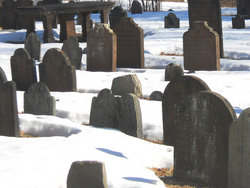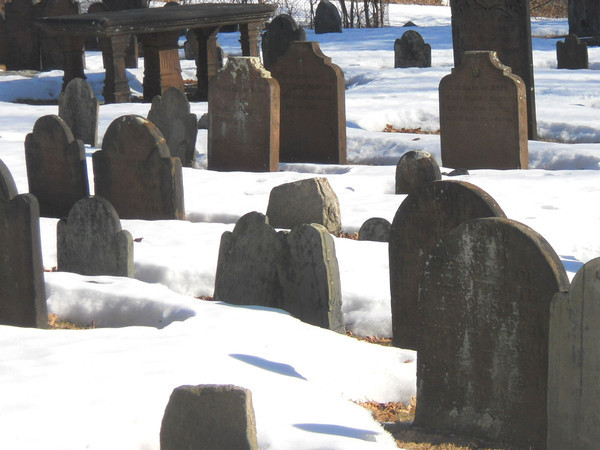Peter owned the Covenant and was united with the New London Church (pastored by Rev. Eliphalet Adams) 23 Apr 1727. His marriage bann from Hannah Morgan (daughter of Capt. John and Ruth Shapley Morgan of Groton) was published 5 Oct 1729 (see DIARY of Joshua Hempstead), and Peter and Hannah were married 13 Nov 1729.
Peter and Hannah had 6 children, 3 of whom lived to adulthood: Peter, 1730-1796 (1. Mary Roath 2. Zipporah Woodworth); Patience, 1732-1747; Green, 1735-1807 (Margaret "Widow Lee" Bolles); Lydia, 1737-1783 (John Manwaring), Lucretia, 1740-1751; and Elisha, 1742-1744.
Following in the footsteps of his Grandfather John (1634-1696), and his Uncle George (who died in a shipwreck off Plumb Island in 1723); in 1732 Peter was associated with others in forming a stock company to engage in trade by sea (much of the New London maritime commerce revolved around the coastal and Caribbean trade, mainly to Barbados and the surrounding islands).
I find reference to this in THE DIARY OF JOSHUA HEMPSTEAD on Thursday, 26 Apr 1733: "I came home & I pd Mr adams 20 [pounds] 15s 3d & Peter Plumbe 2 [pounds] 2s 6d 'Society mony.'"
According to F. M. Caulkins in her HISTORY OF NEW LONDON, the name of this "stock company" was "The New London Society of Trade and Commerce." While the name sounds innocuous, Caulkins goes on to say: "...which being legalized and patronized by the colonial government, went into immediate operation."
Ms. Caulkins continues: "Loans upon mortgate were obtained from the public treasury, and the capital employed by trade. It had about eighty members [including it seems, Pastor Eliphalet Adams, Joshua Hempstead and Peter Plumbe of New London] scattered over the whole colony.
"The society built or purchased several vessels, and embarked in new channels of enterprise. For a couple of years it promised well, giving a great impetus to business. Public opinion was however behind it; and its misfortunes increased its unpopularity."
Moving forward in time, it seems that after several financial setbacks, including loss of both property and life, the "Society" was seeking new ways to support it's ongoing venture: "...To facilitate its operations, the New London society emitted bills of credit or society notes, to run twelve years from the day of date, Oct. 25th, 1732, to Oct. 25th, 1744.
"These bills were hailed by the business part of the community with delight. They went into immediate circulation. But the government was alarmed; wise men declared the whole fabric to be made of paper; and having no solid support, it must soon be destroyed. Very soon the whole colony was in commotion."
At this time (no doubt due to public uproar), the Governor and Colonial Council dissolved the "Society," assuming it's debts; yet, the "...managers determined to hold on, and threatened an appeal to England.
"Nov. 21st, 1733, they had a meeting and Wm. Goddard, from Madeira, having made them a present of a quarter-cask of wine, they knocked out the head, and invited those who had been their enemies to drink; and they themselves drank to the health of the king, queen and Mr. Goddard, and to the prosperity of the society. The great guns were fired, and the sky rang with huzzas. This mode of scattering present trouble was somewhat characteristic of the town.
However, "...When soberer thoughts came, they retraced their steps, and by their own consent ceased to exist. At a meeting held June 5th, 1735, they unanimously dissolved themselves. The distress to which the society had given birth could not be disposed of so easily. The members were impoverished, and hampered with obligations which they could no longer discharge. The evils produced by the association could only be effaced by time."
On 1 Feb 1749, Peter's Uncle, the New London Diarist, Joshua Hempstead (younger brother of Elizabeth, Peter's mother) writes: "Peter Plumbe my Eldest Sisters youngest Son aged about 48 was taken yesterday with Convulsion fitts and Soon deprived of his Reason & Spech & Lyes Senseless. I called to See him, he Expired about 2 clock morn."
Peter owned the Covenant and was united with the New London Church (pastored by Rev. Eliphalet Adams) 23 Apr 1727. His marriage bann from Hannah Morgan (daughter of Capt. John and Ruth Shapley Morgan of Groton) was published 5 Oct 1729 (see DIARY of Joshua Hempstead), and Peter and Hannah were married 13 Nov 1729.
Peter and Hannah had 6 children, 3 of whom lived to adulthood: Peter, 1730-1796 (1. Mary Roath 2. Zipporah Woodworth); Patience, 1732-1747; Green, 1735-1807 (Margaret "Widow Lee" Bolles); Lydia, 1737-1783 (John Manwaring), Lucretia, 1740-1751; and Elisha, 1742-1744.
Following in the footsteps of his Grandfather John (1634-1696), and his Uncle George (who died in a shipwreck off Plumb Island in 1723); in 1732 Peter was associated with others in forming a stock company to engage in trade by sea (much of the New London maritime commerce revolved around the coastal and Caribbean trade, mainly to Barbados and the surrounding islands).
I find reference to this in THE DIARY OF JOSHUA HEMPSTEAD on Thursday, 26 Apr 1733: "I came home & I pd Mr adams 20 [pounds] 15s 3d & Peter Plumbe 2 [pounds] 2s 6d 'Society mony.'"
According to F. M. Caulkins in her HISTORY OF NEW LONDON, the name of this "stock company" was "The New London Society of Trade and Commerce." While the name sounds innocuous, Caulkins goes on to say: "...which being legalized and patronized by the colonial government, went into immediate operation."
Ms. Caulkins continues: "Loans upon mortgate were obtained from the public treasury, and the capital employed by trade. It had about eighty members [including it seems, Pastor Eliphalet Adams, Joshua Hempstead and Peter Plumbe of New London] scattered over the whole colony.
"The society built or purchased several vessels, and embarked in new channels of enterprise. For a couple of years it promised well, giving a great impetus to business. Public opinion was however behind it; and its misfortunes increased its unpopularity."
Moving forward in time, it seems that after several financial setbacks, including loss of both property and life, the "Society" was seeking new ways to support it's ongoing venture: "...To facilitate its operations, the New London society emitted bills of credit or society notes, to run twelve years from the day of date, Oct. 25th, 1732, to Oct. 25th, 1744.
"These bills were hailed by the business part of the community with delight. They went into immediate circulation. But the government was alarmed; wise men declared the whole fabric to be made of paper; and having no solid support, it must soon be destroyed. Very soon the whole colony was in commotion."
At this time (no doubt due to public uproar), the Governor and Colonial Council dissolved the "Society," assuming it's debts; yet, the "...managers determined to hold on, and threatened an appeal to England.
"Nov. 21st, 1733, they had a meeting and Wm. Goddard, from Madeira, having made them a present of a quarter-cask of wine, they knocked out the head, and invited those who had been their enemies to drink; and they themselves drank to the health of the king, queen and Mr. Goddard, and to the prosperity of the society. The great guns were fired, and the sky rang with huzzas. This mode of scattering present trouble was somewhat characteristic of the town.
However, "...When soberer thoughts came, they retraced their steps, and by their own consent ceased to exist. At a meeting held June 5th, 1735, they unanimously dissolved themselves. The distress to which the society had given birth could not be disposed of so easily. The members were impoverished, and hampered with obligations which they could no longer discharge. The evils produced by the association could only be effaced by time."
On 1 Feb 1749, Peter's Uncle, the New London Diarist, Joshua Hempstead (younger brother of Elizabeth, Peter's mother) writes: "Peter Plumbe my Eldest Sisters youngest Son aged about 48 was taken yesterday with Convulsion fitts and Soon deprived of his Reason & Spech & Lyes Senseless. I called to See him, he Expired about 2 clock morn."
Gravesite Details
Peter and Hannah Plumbe were members of the New London, New London Church. There is no evidence they and their children were buried at any other location.







